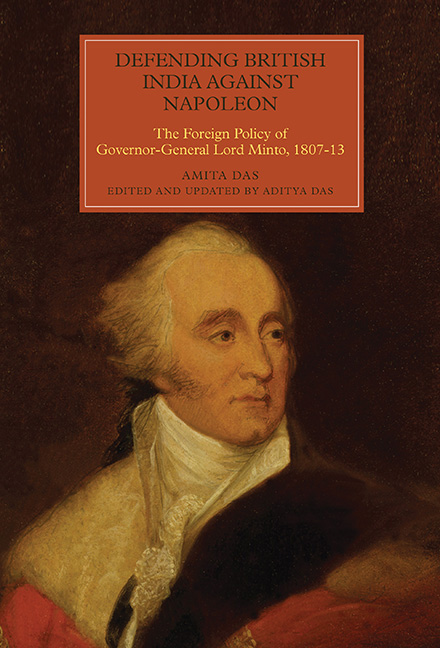Book contents
- Frontmatter
- Dedication
- Contents
- List of Illustrations
- Preface
- Abbreviations
- Chapter 1 Setting the Stage
- Chapter 2 Positioning in Persia
- Chapter 3 Creating a Buffer Zone
- Chapter 4 Protecting Trade and Supply Lines
- Chapter 5 Pre-empting French Influence in Java
- Chapter 6 Legacy of Lord Minto
- Appendix Government of the East India Company
- Bibliography
- Index
- Worlds of the East India Company
Chapter 2 - Positioning in Persia
Published online by Cambridge University Press: 11 May 2021
- Frontmatter
- Dedication
- Contents
- List of Illustrations
- Preface
- Abbreviations
- Chapter 1 Setting the Stage
- Chapter 2 Positioning in Persia
- Chapter 3 Creating a Buffer Zone
- Chapter 4 Protecting Trade and Supply Lines
- Chapter 5 Pre-empting French Influence in Java
- Chapter 6 Legacy of Lord Minto
- Appendix Government of the East India Company
- Bibliography
- Index
- Worlds of the East India Company
Summary
Britain's West Asia Policy and Strategies against the French Threat
The French East India Company (Compagnie des Indes Orientales) had been founded at the instigation of Jean-Baptiste Colbert with investment capital amounting to fifteen million livres tournois (approximately £600,000) in 1664. A decade later, Francois Martin established its Indian headquarters at Pondicherry, eighty-five miles south of Madras on the Coromandel Coast. Following the British pattern of settlement, the French established subsidiary factories at Surat (Gujarat) and Chandarnagar (Bengal) on the banks of the Hughli River (Ganges delta) and by the end of the century were competing with the English factories for the Indian market. By seizing the islands of Ile de France (Mauritius) and Bourbon in the Indian Ocean after 1721, France was able to keep its fleet ready for offensive and defensive action against any Indian port. The French reached their peak profit in India in the late eighteenth century with average rate of return of 25 per cent annually on their investment, while the much larger and more cumbersome British company profits were down to under 10 per cent in the same period, although British imports from India were valued at over one million pounds annually. The era of fellow European cooperation and friendship in the ‘hostile Orient’ was rapidly being replaced by tensions of competitive trade, national rivalry and jealousy. In 1741, Pondicherry came under the presidency of Joseph Francois Dupleix (1697–1764), son of his company's director-general and a statesman of foresight. Its population at the time was about the same as that of Madras, close to 50,000. Five years later, the European war over Maria Theresa's disputed claim to the Austrian succession lured Britain and France into a conflict that erupted in southern India in the summer of 1746. The British captured several French ships, which provoked Dupleix to call for the fleet under the command of Admiral Mahe de la Bourdonnais at Ile de France, swiftly turning the tide along the Coromandel Coast in France's favour. Madras was easily captured by the French in September 1746 and among those taken prisoner at Fort St George was young Robert Clive (1725–74), a ‘writer’ in the company's civil service who had earlier been so bored with his counting house job that he had tried unsuccessfully to blow out his own brains with a pistol that misfired.
- Type
- Chapter
- Information
- Defending British India against NapoleonThe Foreign Policy of Governor-General Lord Minto, 1807-13, pp. 24 - 90Publisher: Boydell & BrewerPrint publication year: 2016



